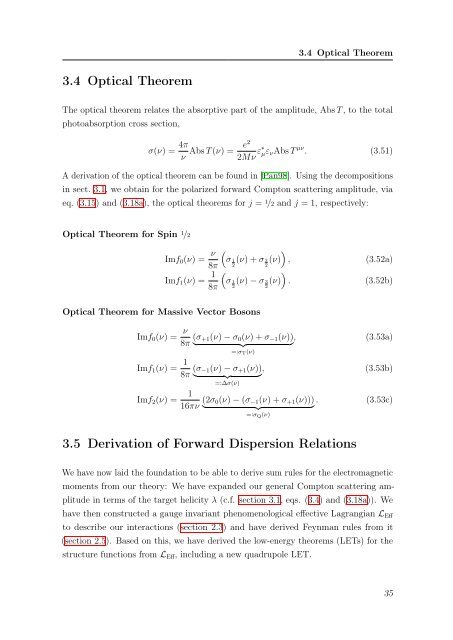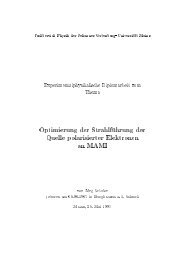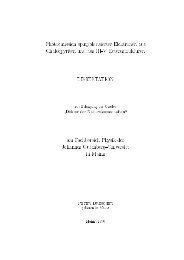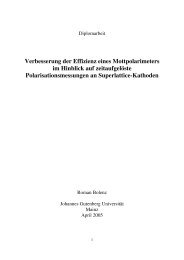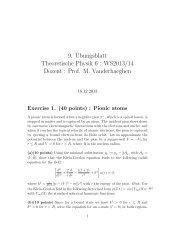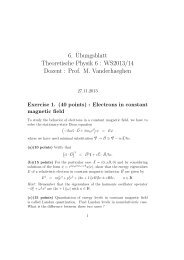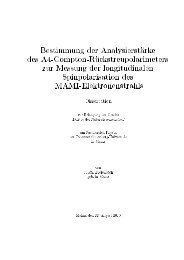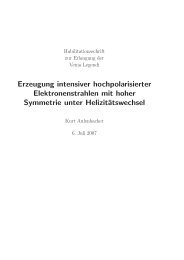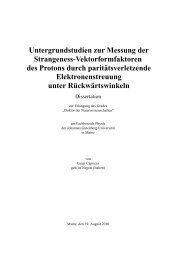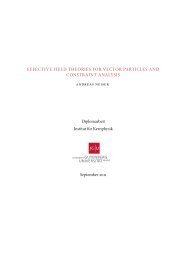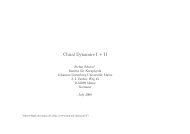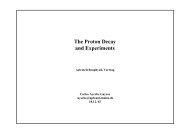Compton Scattering Sum Rules for Massive Vector Bosons
Compton Scattering Sum Rules for Massive Vector Bosons
Compton Scattering Sum Rules for Massive Vector Bosons
Create successful ePaper yourself
Turn your PDF publications into a flip-book with our unique Google optimized e-Paper software.
3.4 Optical Theorem<br />
3.4 Optical Theorem<br />
The optical theorem relates the absorptive part of the amplitude, Abs T , to the total<br />
photoabsorption cross section,<br />
σ(ν) = 4π ν<br />
Abs T (ν) =<br />
e2<br />
2Mν ε∗ µε ν Abs T µν . (3.51)<br />
A derivation of the optical theorem can be found in [Pan98]. Using the decompositions<br />
in sect. 3.1, we obtain <strong>for</strong> the polarized <strong>for</strong>ward <strong>Compton</strong> scattering amplitude, via<br />
eq. (3.15) and (3.18a), the optical theorems <strong>for</strong> j = 1 /2 and j = 1, respectively:<br />
Optical Theorem <strong>for</strong> Spin 1 /2<br />
Imf 0 (ν) = ν (<br />
8π<br />
(<br />
Imf 1 (ν) = 1<br />
8π<br />
σ 1<br />
2<br />
σ 1<br />
2<br />
(ν) + σ 3<br />
2<br />
)<br />
(ν)<br />
)<br />
(ν) − σ 3 (ν)<br />
2<br />
Optical Theorem <strong>for</strong> <strong>Massive</strong> <strong>Vector</strong> <strong>Bosons</strong><br />
, (3.52a)<br />
. (3.52b)<br />
Imf 0 (ν) = ν<br />
8π (σ +1(ν) − σ 0 (ν) + σ −1 (ν)), (3.53a)<br />
} {{ }<br />
=:σ T (ν)<br />
Imf 1 (ν) = 1<br />
8π (σ −1(ν) − σ +1 (ν)), (3.53b)<br />
} {{ }<br />
=:∆σ(ν)<br />
Imf 2 (ν) = 1<br />
16πν (2σ 0(ν) − (σ −1 (ν) + σ +1 (ν))) . (3.53c)<br />
} {{ }<br />
=:σ Q (ν)<br />
3.5 Derivation of Forward Dispersion Relations<br />
We have now laid the foundation to be able to derive sum rules <strong>for</strong> the electromagnetic<br />
moments from our theory: We have expanded our general <strong>Compton</strong> scattering amplitude<br />
in terms of the target helicity λ (c.f. section 3.1, eqs. (3.4) and (3.18a)). We<br />
have then constructed a gauge invariant phenomenological effective Lagrangian L Eff<br />
to describe our interactions (section 2.3) and have derived Feynman rules from it<br />
(section 2.5). Based on this, we have derived the low-energy theorems (LETs) <strong>for</strong> the<br />
structure functions from L Eff , including a new quadrupole LET.<br />
35


